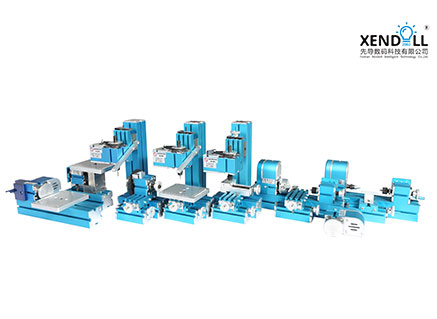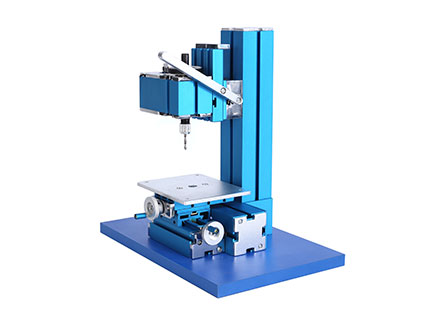Blog
Xendoll has 22 years of experience in the production of small machine tools. We will help you choose the suitable machine and share our experience in CNC machining with you.
 Sep 22, 2024
Sep 22, 2024
 Xendoll
Xendoll
 1362
1362
In CNC (Computer Numerical Control) machining, several factors influence the precision, efficiency, and overall success of the machining process. Among these, the feed rate stands out as a crucial parameter that directly impacts not only the machining speed but also the quality of the finished product. The feed rate refers to the speed at which the cutting tool moves in relation to the workpiece during the machining process. Proper adjustment of this rate is essential for achieving the desired results.
Understanding the Feed Rate
The feed rate is generally measured in terms of distance per unit of time, such as millimeters per minute (mm/min) or inches per minute (in/min). This rate represents the velocity at which the tool traverses the surface of the material being worked on. In a CNC machine, the feed rate is controlled via the CNC program, which allows for precise and repeatable movements of the cutting tool based on predefined parameters.
The feed rate, in combination with spindle speed and depth of cut, determines how efficiently and effectively a CNC machine can perform its operations. Whether you are drilling, milling, or turning, the correct feed rate plays a crucial role in controlling the tool's engagement with the workpiece, influencing factors such as surface finish, tool wear, and dimensional accuracy.
In CNC machining, there are two primary types of feed:
1. Cutting Feed (F): Often referred to simply as "feed," cutting feed is the rate at which the cutting tool moves into the workpiece during the cutting process. It determines the thickness of the material removed with each pass. This feed is critical for various operations like milling, turning, drilling, and facing.
2. Traverse Feed (G): Also known as "rapid feed" or "traverse rate," traverse feed is the speed at which the tool moves between cutting operations or repositions to a different location on the workpiece. It is used when the tool is not engaged with the material and is essential for minimizing non-cutting time and enhancing overall efficiency.
Key Factors Influencing the Feed Rate
Selecting the correct feed rate involves understanding the interaction of several factors that vary depending on the specific application. These factors include:

1. Material of the Workpiece
The material being machined has a significant impact on the choice of feed rate. Harder materials such as stainless steel, titanium, or hardened alloys require slower feed rates to prevent tool wear or breakage. The cutting forces involved in machining these materials are much higher than in softer materials like aluminum or plastic. If the feed rate is too high for hard materials, the cutting tool may experience excessive friction, heat, and stress, which can result in rapid deterioration or even catastrophic failure.
On the other hand, softer materials can handle faster feed rates, enabling quicker machining processes without compromising the tool's lifespan. However, even with softer materials, excessive feed rates can result in poor surface finishes and inaccuracies in the final dimensions. Finding the right balance is critical to optimizing both efficiency and quality.
2. Tool Type and Size
The type and size of the cutting tool also play a pivotal role in determining the feed rate. Larger tools can typically handle higher feed rates due to their increased strength and ability to withstand greater cutting forces. For example, a large end mill can remove more material per pass compared to a small one, enabling faster machining with fewer tool passes.
Conversely, smaller tools are more delicate and must operate at lower feed rates to avoid damage or premature wear. For intricate or fine machining tasks requiring small-diameter tools, such as precision drilling or engraving, operators must carefully reduce the feed rate to ensure that the tool remains intact and that the desired level of detail is achieved.
Additionally, the material of the tool itself—whether it's high-speed steel (HSS), carbide, or ceramic—can influence the appropriate feed rate. Carbide tools, for example, can generally withstand higher feed rates than HSS tools due to their superior hardness and heat resistance.
3. Cutting Depth
The depth of cut, or how deeply the tool penetrates the workpiece material in each pass, is another crucial factor. Deeper cuts require more cutting force and generate more heat, which in turn demands lower feed rates to prevent tool damage and maintain acceptable surface finishes.
When performing shallow cuts, operators can increase the feed rate, allowing for faster material removal without significant risk of tool failure. However, when deeper cuts are needed, the feed rate must be reduced to maintain stability, accuracy, and surface integrity. A high feed rate in conjunction with a deep cut can lead to issues such as tool deflection, excessive wear, and poor dimensional accuracy.
4. Machine Tool Capabilities
The capabilities of the CNC machine itself set practical limits on the feed rate. Modern CNC machines are designed to handle a wide range of feed rates, but there are still physical limitations based on the power, rigidity, and precision of the machine.
Older or less powerful machines may have slower maximum feed rates, as they might lack the structural rigidity or spindle power to support rapid tool movements without experiencing issues such as vibration or chatter. High-speed CNC machines, on the other hand, can handle faster feed rates, allowing for more efficient production times. However, even in high-speed machines, pushing the feed rate beyond the machine's optimal range can lead to precision issues, tool wear, and potential breakdowns.

Impact of Feed Rate on Machining Outcomes
1. Surface Finish
The feed rate has a direct impact on the surface finish of the machined part. A slower feed rate generally results in a smoother finish because the cutting tool makes more fine, controlled movements across the material. For applications requiring a high level of surface polish or finish, such as in mold making or aerospace components, lower feed rates are often preferable.
Conversely, a higher feed rate can result in a rougher surface finish, especially when cutting hard or brittle materials. This is because the tool removes more material in each pass, leading to more pronounced tool marks on the workpiece. For roughing operations where surface finish is not the primary concern, higher feed rates may be acceptable to maximize material removal efficiency.
2. Tool Life
Tool wear is inevitable in CNC machining, but the feed rate can either accelerate or reduce the rate at which a tool degrades. A feed rate that is too high can cause excessive wear by increasing friction and heat generation at the tool-workpiece interface. This can lead to premature tool failure, reducing tool life and increasing costs associated with tool replacement.
A properly adjusted feed rate helps extend tool life by minimizing wear and maintaining optimal cutting conditions. Using lower feed rates for harder materials and deeper cuts is one way to preserve the longevity of cutting tools.
3. Dimensional Accuracy
Dimensional accuracy is another critical aspect of CNC machining that is influenced by the feed rate. A higher feed rate can increase the likelihood of tool deflection, where the tool bends slightly due to cutting forces, leading to inaccuracies in the final dimensions of the part. For precision machining, particularly in industries such as medical device manufacturing or aerospace, even minor deviations can result in part rejection or the need for costly rework.
By adjusting the feed rate appropriately, operators can ensure that the tool remains stable throughout the machining process, reducing the risk of dimensional inaccuracies.
Conclusion: The Importance of Adjusting Feed Rate in CNC Machining
In CNC machining, the feed rate is not just a number—it is a critical parameter that affects the quality, efficiency, and cost-effectiveness of the machining process. Selecting the optimal feed rate requires a careful analysis of factors such as material hardness, tool size, cutting depth, and machine capabilities. By understanding and adjusting the feed rate based on these variables, operators can optimize production, extend tool life, and achieve the desired surface finish and dimensional accuracy.
Ultimately, mastering the art of feed rate adjustment is key to successful CNC machining, ensuring that each part is machined to exacting standards while minimizing waste and maximizing productivity.
For details, please refer to the following link:https://www.xendolltools.com/category/micro-cnc-machine.html



 Show all our samples
Show all our samples
 Provide you with a free quote
Provide you with a free quote
 Answer all the questions you may have
Answer all the questions you may have
 Guided installation and other options
Guided installation and other options